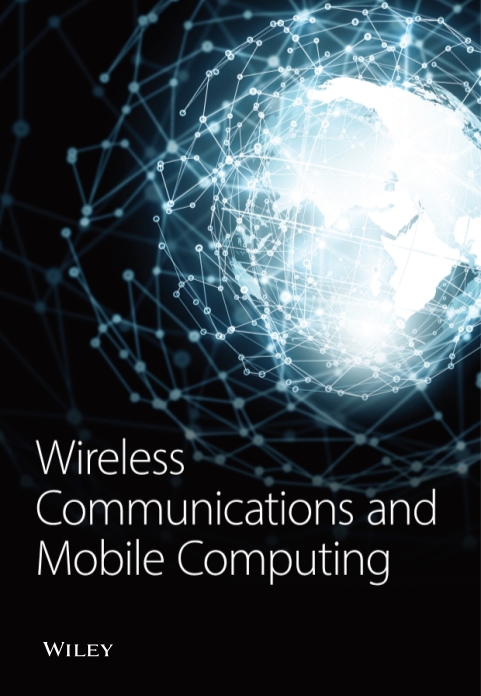[Retracted] Analysis on the Sharing Method of English Mobile Education Resources Based on Wireless Broadband Connection
Abstract
The sharing of English educational resources has always been a research hotspot in the English industry. The traditional English educational resource sharing system has low resource sharing efficiency and no real-time contribution capability. Therefore, this paper proposes a method to analyze the characteristics of online educational resources. By comparing the main features of the IEEE802 wireless standard series, the IEEE802.16 protocol stack model is constructed by using the IEEE802.16 protocol, the business layer design and CS layer of the English education resource system are realized through the MAC layer and the CPS layer, and the mobile English education resource sharing system is analyzed. Live voting service: in order to improve the sharing speed of mobile English education resources, an NRTPS uplink bandwidth allocation mechanism is proposed, and the design of a mobile English education resource sharing system based on wireless broadband connection is realized. The experimental results show that the resource sharing efficiency of the system is high, and it plays an important role in the development of English education.
1. Introduction
Nowadays, science and technology are developing rapidly, especially in the field of communication. Communication technology is closely related to people’s life. Now, traditional voice and data services can no longer meet the needs of the market, and people’s demand for English is increasing. The demand of the market promotes the progress of technology, and the continuous development of technology is just to meet the needs of people’s life [1]. With the increasing demand for English application, with broadband transmission and diversification of services becoming the trend of communication development, the core network has the characteristics of super high speed and super capacity, so the construction of broadband access network has become the bottleneck problem that must be solved in English education. Among them, broadband wireless access is gaining favor in the industry with its advantages such as flexible networking, convenient upgrade and maintenance, and high-speed two-way data transmission [2]. At present, the application of MMDs, LMDs, Wi-Fi, HSDPA, SCDMA, and other wireless broadband technologies is on the rise, and their great role in the sustainable development of society and economy has been recognized and paid attention by all sectors of society. The government management departments are also actively researching and promoting the experimental work of wireless broadband technology with a positive and pragmatic attitude [3]. Nowadays, various broadband wireless access technologies are booming to provide users with higher speed access and meet people’s various mobile English education needs. They have become an indispensable and important component of mobile English education.
Therefore, this paper studies the mobile English education resource sharing system based on wireless broadband connection.
- (1)
This paper proposes a method to analyze the characteristics of online educational resources
- (2)
By comparing the main features of the IEEE802 wireless standard series, the IEEE802.16 protocol stack model is constructed by using the IEEE802.16 protocol, and the business layer design and CS layer of the English education resource system are realized through the MAC layer and the CPS layer, and the mobile English education is analyzed
- (3)
The NRTPS uplink bandwidth allocation mechanism is proposed, and the design of the mobile English education resource sharing system based on wireless broadband connection is realized
2. Characteristics of English Online Education Resources
It refers to a learning community by the learners and helping the scholars (including teachers and mentors) together, and they often help each other in the process of learning to communicate and exchange, share all sorts of study resource, with some learning tasks, thus formed the mutual influence between the members, and promote each other relationship [4]. In this paper, mobile English learning community refers to English learning network practice community. Modern mobile English education requires people to use computerized media and network communication technology to organize teaching, implement all aspects of teaching, and communicate, so as to complete the process of mobile English teaching. In this teaching method, the separation of teachers and students in time and space requires learners to have a high degree of independent learning ability, that is, to be able to conduct independent learning [5]. In this learning process, learners embody the five characteristics of self-identification, self-guidance, self-reinforcement, self-adjustment, and self-supervision.
According to the training of innovative talents in The Times and the evaluation of educational resources at home and abroad, in order to give full play to the role of educational resources in educational reform and innovative talent training, the shared educational resources should be unified planning, which should have the characteristics of timeliness, flexibility, life, diversification, and interest.
3. Research on Mobile English Education Resource Sharing Based on Wireless Broadband Connection
Broadband wireless access technology can be applied to four types of networks, which are wireless individual domain networks, wireless LOCAL area networks, wireless metropolitan area networks, and wireless wide area networks [6] according to the size of the main coverage areas and in the order from small to large. The broadband access network and corresponding technical standards are shown in Figure 1.
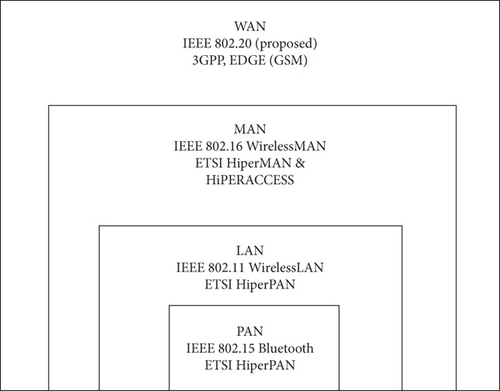
Broadband wireless access technology represented by Wi-Fi, WIMAX, and other technologies is a new force in the field of broadband access. Compared with wired access, this kind of technology has less start-up capital, less initial investment, short construction period, fast service provision, and great flexibility in development and can dynamically allocate system resources according to user needs. It has low system maintenance cost and many advantages [7]. And its high-speed access rate, even some wired access technology is difficult to reach, for the development of broadband data integrated services provided a possibility. Table 1 compares the main characteristics of various broadband access technical standards [8].
| Standard series | Operating frequency band | Working rate | Coverage distance | Network application | Main features and applications |
|---|---|---|---|---|---|
| IEEE802.20x | Below 3.5 GHZ | 16 Mbps/40 Mbps | 1-15 kilometres | WWAN | Point to multipoint wireless connection is used for high-speed mobile wireless access. The access rate of mobile users can reach IMbPs, which is oriented to global search and coverage |
| IEEE802.16x | 2~11/11~66 GHZ | 70 Mbps | 1-50 kilometres | WMAN | Point to multipoint wireless connection supports roaming and switching between base stations for the following: (1) WLAN service access, (2) wireless DSL for metropolitan area coverage, and (3) mobile communication base station backhaul link and enterprise access network |
| IEEE802.11x | 2.4/5 GHZ | 1-54/Mbps | 100 rice | WLAN | Point to multipoint wireless connection, support switching between APs, for the following: (1) Enterprise WLAN, (2) PWLAN, and (3) Home/SOHO wireless gateway |
| IEEE802.15x | 2.4 GHZ/3.1~10.6 GHZ | 0.25/1-55/110 Mbps | 10-75 rice/10 rice | WPAN | Point to point short distance connection, working in personal operating environment, used for high-speed data network in home and office; IEEE802.15.4 works at low rate and is used for home control gateway |
The wireless environment is more complex than the wired environment, and a single wireless technology will not be applicable in all fields. In the previous introduction, we can see that all kinds of wireless communication technologies have their own characteristics and advantages and also have their own different market positioning. The development of various wireless access technologies is analyzed [9].
3.1. IEEE802.16 Protocol Stack
The protocol stack model of IEEE802.16 specification is shown in Figure 2. The air interface is composed of the physical layer and the MAC layer. The MAC layer is divided into three sublayers: the specific service aggregation sublayer (CS), the common part molecular layer (CPS), and the security sublayer (SS).
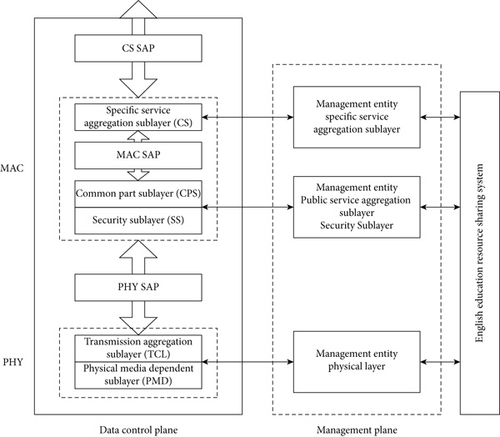
There are two WIMAX modes: PMP and Mesh. The main difference between PMP and optional Mesh mode is that in PMP mode, services only occur between MS and BS, while in Mesh mode, services establish indirect connections with BS through other nodes, and direct connections can be established between MS and MS [10]. Only the PMP mode is studied in this article.
In PMP mode, there is a central BS and an antenna capable of processing multiple independent sectors simultaneously. In the downlink direction, in a given frequency channel and antenna sector, all MS may receive the same transmission or part thereof. BS is the only sender in the downlink direction. Downlinks are generally broadcast [11]. If it is not specified in the DL MAP message that a part of the bottom subframe is a specific MS, then all MS that can listen to that part of the bottom subframe will listen. The MS checks the connection identifiers of the PDUs it receives and keeps the PDUs it sends to itself. In the uplink direction, MS shares the uplink to BS [12]. According to different types of services, MS may get the right to send continuously, or BS may grant it the right to send after receiving the request from MS. Different uplink scheduling mechanisms can be used to meet the latency and bandwidth requirements of each user’s application [13].
3.2. Business Level Design of English Education Resource System
3.2.1. MAC Layer
The MAC layer is connection-oriented. In order to map different types of services and provide corresponding QoS levels according to the type of service, all data communication must be built on the basis of connection. The connection between MS and BS is identified by a 16-bit CID. Three management connections are established at MS initialization: the basic management connection (for interacting with short, real-time MAC messages), the primary management connection (for delivering long, nonreal-time MAC messages), and the secondary management connection (for interacting with delayed, standard-based management messages) [14]. Only the managed MS will establish a second managed connection with the BS. For connectionless IP data flows, CID can also be regarded as an identifier of the IP data flow. The CID can be used to index the destination of the connection and the information related to the connection. A 16-bit CID allows a maximum of 64 K upstream or downstream connections. Service flow provides a mechanism for uplink and downlink QoS management, especially closely related to the bandwidth allocation process [15]. The upstream bandwidth of an MS request is based on a connection, while the bandwidth granted by BS to MS is based on an MS. Once established, the connection needs to be maintained. The maintenance requirements vary according to the service type of the connection. Connections can also be terminated, and either BS or MS can be initiated, usually when a user’s business contract changes [16].
In short, THE PMP mode is a centralized network structure, that is, one BS corresponds to multiple MS. Any MS needs to communicate is transmitted through BS. Therefore, all communication occurs between BS and MS, and BS centrally controls and manages all MS communications in a sector. The downlink transmits data in broadcast mode. Multiple MS share the uplink, and BS is responsible for bandwidth allocation.
3.2.2. CS Layer Design
The service aggregation sublayer is located on top of MACCPS. It maps all external network data received from the aggregation service access point (CSS) into MACSDU and sends the data to MACCPS through MACSAP. The main function of the aggregation sublayer is to map connection-oriented common part services to standard types of services. There are two main types of CS: ATMCS and Packet CS. Only Packet CS is studied in this paper [17].
Send CS is responsible for passing MACSDU to MACSAP. The MAC is responsible for passing the MACSDU to the peer MACSAP, including QoS, segmentation, connection, and other transport functions, as well as the traffic characteristics of a particular connection. The receiving CS is responsible for receiving the MACSDU from the peer MACS and passing it to the high-level entity. The Packet CS is responsible for transmitting all packet-based protocols such as IP, PPP, and IEEE: TD802.3 (Ethernet). The Packet CS optionally supports PHS compression of payload data headers. PHS eliminates the duplication of header information at the sending end and reconstructs the information at the receiving end by certain rules. PHS makes the transmission of data with multiple layers of headers more efficient. This feature improves bandwidth utilization and is especially important for applications such as VOIP. The CS layer function diagram is shown in Figure 3.
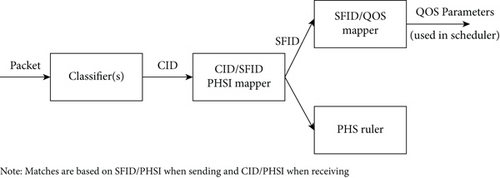
3.2.3. The CPS Layer Design
The MAC common segment molecular layer provides reliable, connection-oriented, and quality-of-service (QoS) packet data traffic over the unreliable physical layer MPDU traffic. Each connection has corresponding QoS characteristics, which are determined by the base station.
The format of macPDUs is shown in Figure 4. Each PDU begins with a fixed-length MACHeader, which may be followed by the PDU payfoad. If payLOed exists, payLOed may contain zero or more MAC subheaders and zero or more MACSnu or SDU segments. The MACPDU is of variable length so that it can carry the traffic of various upper-layer entities without knowing the upper-layer data format. MACPDUs may contain a CRC check, which is required for SCa, OFDM, and OFDMA physical layers. IEEE802.16 defines two MACHeader: formats: GenericMACHeader: format and bandwidth request header. The generic MAC header is followed by the contents of the MAC layer’s management message or data from the CS aggregation sublayer [18].

UGS is mainly used for real-time services that generate fixed-length data packets periodically (from a few milliseconds to dozens of milliseconds), such as VOIP without mute compression. The BS periodically provides a fixed size of bandwidth to users based on the service cycle and the length of data packets. This reduces the bandwidth overhead and delay of MS requests for the service and ensures that the real-time service requirements are met. BS will periodically provide BURSTS of IE that transmits data to MS based on the maximum continuous transmission rate. The bandwidth allocated in IE should be large enough to accommodate the data length and MAC layer overhead specified by the dynamic traffic flow. Figure 4 illustrates the UGS uplink bandwidth allocation mechanism. When BS allocates bandwidth, it must allocate a large bandwidth to the corresponding connection and consider the delay requirement. Therefore, the request/transmission policy must specify that the connection is not allowed to send bandwidth requests in competitive mode. UGS must set the following QoS parameters: maximum sustained transmission rate, maximum delay, jitter tolerance, and request/transmission policy. If a minimum reserved transfer rate is to be given, the value should be equal to the maximum sustained transfer rate.
In UGS, the MAC layer packet allocation management (GM) subheader is also used, which is mainly used by MS to transmit the related state of UGS service to BS. The highest bit of the GM is the slipindieator (51: slipindieator). During the actual operation, the data transfer speed of the business may exceed the QoS maximum continuous transfer rate at some point due to clock bias. In this case, the data will accumulate in the local queue of MS data waiting to be sent, or the MS will receive the MAP error, and the data will be stored once the length of the data queue exceeds a certain threshold, and the dislocation indicator should be set to 1. In this case, BS will allocate up to 1% more bandwidth to the corresponding connection for compensation and adjustment. When the length of the data queue falls below the threshold, the dislocation indicator should be 0. As soon as a UGS service is transmitting data on the MS, BS stops all periodic polling on the MS. If any other non-UGS connection on the MS that supports polling has data to send, it sets the polling bit (pM: poll-me) in the GM header of the packet UGS to request BS, to allocate the bandwidth, to send the request time slot, and to send bandwidth request. Because MS does not immediately get the bandwidth request time slot allocated by BS after polling location 1, all UGS packets sent by MS during this period will be polling location.
3.3. Real-Time Polling Service of Mobile English Education Resource Sharing System
RTPS is mainly used in real-time demand, periodic (tens of milliseconds to hundreds of milliseconds) to generate variable length packets of business, such as MPEG video and video conference. The BS sends a unicast bandwidth request time slot to the MS in real time based on QoS parameters related to the service. The MS sends a bandwidth request to the BS on this time slot to inform the BS of the uplink bandwidth required for the corresponding connection. Figure 5 illustrates the RTPS uplink bandwidth allocation mechanism. BS schedules the current bandwidth according to certain rules and allocates the uplink data and request bandwidth to the corresponding MS connections. After obtaining the uplink data bandwidth, the MS sends the data. Due to the introduction of bandwidth requests, this service is more expensive at the MAC layer than UGS, but it can dynamically allocate bandwidth according to the size of the upper-layer service data, so it optimizes the efficiency of data transmission.
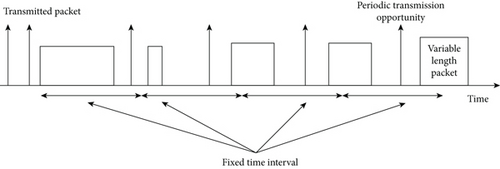
Because the service is for real-time business, BS will provide unicast bandwidth request opportunity to the connection using RTPS service periodically, so as to effectively guarantee the real-time demand of business. The RTPS service also does not support related connections to send bandwidth requests over the bandwidth request contention slots, so the request/transport policy in the QoS parameter set of the related service flow will explicitly specify that the bandwidth request contention slots are not allowed. Regardless of whether the previous bandwidth request has been satisfied, BS regularly allocates the next unicast bandwidth request time slot strictly according to the polling interval of QoS parameters. The required QoS parameters include the maximum sustained transmission rate, maximum delay, minimum reserved transmission rate, and request/transmission policy. On the basis of the above, mobile sharing of mobile English education resources is realized.
4. Experiment
4.1. Experimental Parameter Design
Different from the traditional sharing mode of teaching resources, the realization of sharing network teaching resources requires the organic combination of teaching management and modern distance education. This requires the school multimedia equipment really applied to the actual teaching process, the establishment of each school’s network teaching platform website, and teaching platform with all grades of each subject of excellent courseware, mainly the national famous courseware for primary and secondary schools. Of course, excellent education resource sharing is built on the basis of perfect website resource construction technology, so ZX website must achieve the best technical perfection of resource sharing system before the online education resource sharing platform for primary and secondary schools is put into operation, so as to ensure the system security and the normal operation of system functions. The operating environment of the website management system (as shown in Table 2) is the most basic requirements. The best effect of the website background management interface is under the resolution of 1024 × 1024 configuration requirements:
| Project | Detailed |
|---|---|
| Operating system | Windows 2000,Windows XP, Windows 2003 |
| Script interpreter | Vbscripts 5, 6, or above |
| Web server | II S5. 0 or IIS6. 0 |
| Data engine |
|
| Permission requirements | Have permissions to create tables and backup SQL server databases |
| Space size | At least 30 m free space for initial installation |
| Hardware requirements | PIII 500 CPU 256 M memory or higher |
| Bandwidth requirements | 10 M share or higher |
| Email function | Install one of Jmai14.0, Cdonts, Aspemail, or WEBEasyMail |
| Generate thumbnails | Install AspJpeg version 1.4 or above |
The performance of mobile English resource education system is analyzed according to the above parameters.
5. Experimental Measurement
This system is built on a large-scale cluster. In addition to the traditional system test, what is more important is whether the system operation is stable and the response speed is acceptable when the system load is large and the parallel data is large. The professional testing software Bench4Q Tool was used in the test. It can provide a very open test environment for J2EE application services.
5.1. Resource Transmission Speed of English Education Resource Sharing System
In order to verify the transfer speed of mobile English education resource sharing system, a simulation experiment is needed. This paper compares the resource transmission speed of English education resource sharing system of the method in this paper, the method in literature [2], and the method in literature [3]. In the case of the same amount of mobile English resource data, the shorter the resource sharing time, the higher the resource transmission rate. The specific results are shown in Table 3.
It can be seen from Table 3 that the transmission speed of network resources in this paper is the highest under the same number of people carrying the system. When carrying 300 people, the network resource transmission speed of this system is 30 GB, the network resource transmission speed of literature [2] is 0.43 GB, and the network resource transmission speed of literature [3] is 0.53 GB. When carrying 600 people, the network resource transmission speed of the system in this paper is 25 GB, the network resource transmission speed of the system in literature [2] is 0.23 GB, and that in literature [3] is 0.35 GB. The transmission speed of network resources in this system is obviously faster.
5.2. Performance Test Results of Mobile English Education Resource Sharing System
Bench4Q Tool is used for cluster load test, and three groups of concurrent data are simulated to observe the performance of the platform during the test, and the concurrent data of 100, 500, 1000, or even larger can be obtained. Through the test data, it can be found that when the amount of concurrent data is less than 1000, the differentiation of indicators such as thinking time and tolerance time is not large; when the amount of data continues to increase, the above indicators do not increase with the speed of data growth. System performance test results is shown in Figure 6.
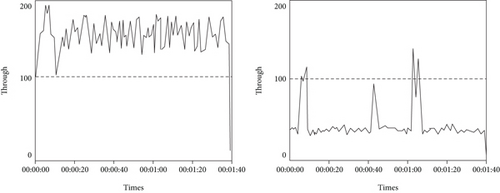
Due to concurrent data amount is less than 800 when the data was no significant difference, so in the concurrent data for 1000, at the beginning of the performance test data volume testing time is 2 minutes, above Figure 6(a) shows the number of interaction platform to complete every second, and Figure 6(b) is needed to complete an interaction time; the two parts of the data will change with the change of the quantity of concurrent data.
In order to exclude the contingency of the test, the machine was restarted after the first test and the resources occupied by the first test were released for the second test. The amount of concurrent data was still 100, 500, and 1000. The test results showed that the indicators such as thinking time and tolerance time were consistent with the first test. As can be seen from the above tests, the advantage of the education resource sharing system built based on wireless broadband connection is that its service performance is better than the traditional education resource sharing system when it is deployed in large-scale applications.
6. Conclusion
- (1)
The transmission speed of network resources of this system is 25 GB, which indicates that this system has significantly improved the transmission speed of network resources
- (2)
The concurrent data volume was 100, 500, and 1000, and the test results showed that the indexes such as thinking time and tolerance time were consistent with the first time. This shows that the service performance of the education resource sharing system based on wireless broadband connection is better than that of the traditional education resource sharing system when the large-scale application is deployed
Conflicts of Interest
The authors declare that they have no known competing financial interests or personal relationships that could have appeared to influence the work reported in this paper.
Open Research
Data Availability
The data used to support the findings of this study are available from the corresponding author upon request.



